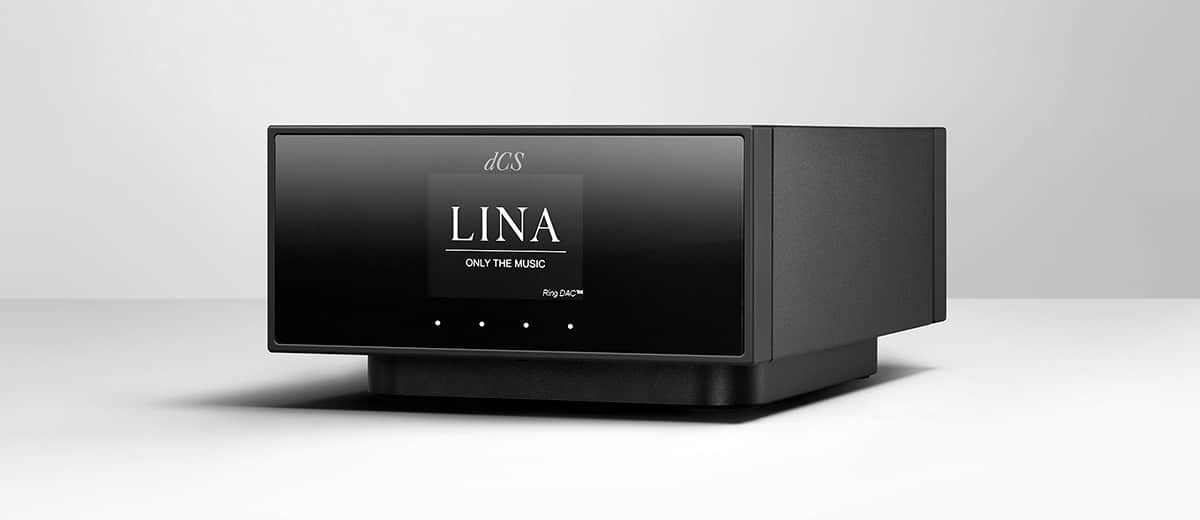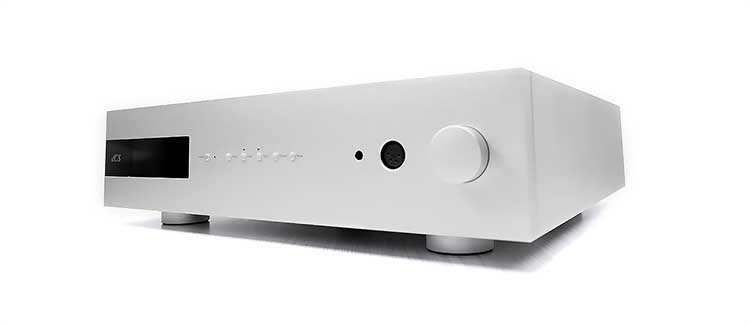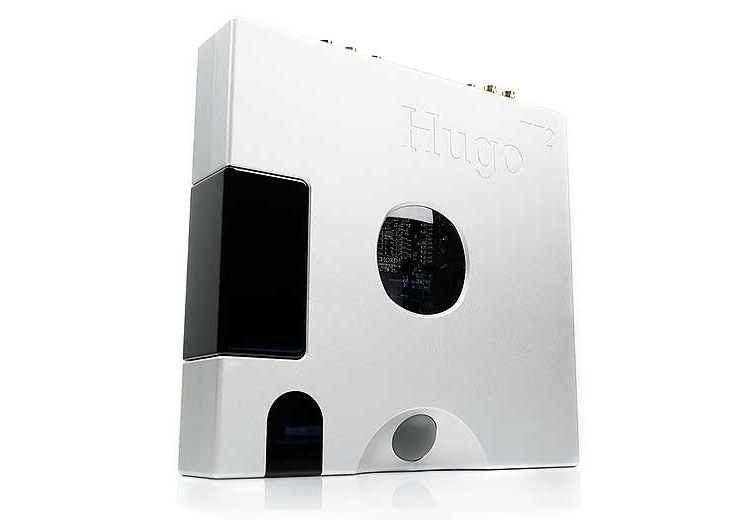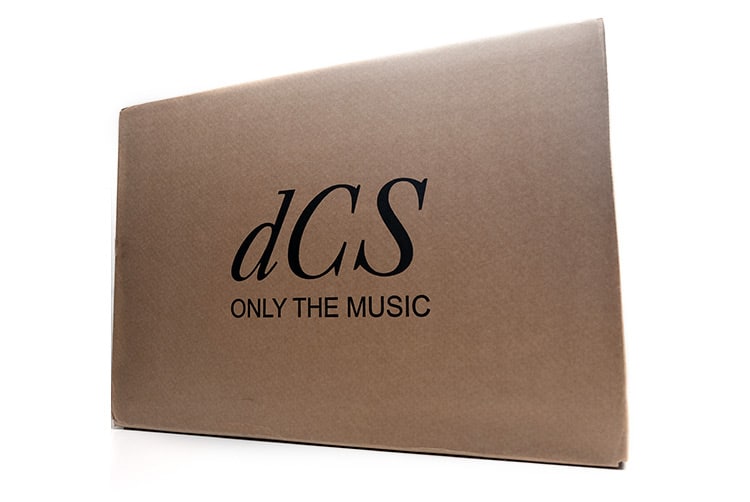Select Comparisons
dCS Bartok
$14500 (DAC only)
The Bartok is somewhat of a precursor to the Lina and was reviewed by us in 2020. It is still priced at a higher level than the Lina with a recent firmware upgrade, (Bartok 2.0).
Technical
Both of these devices use the non-APEX Ring DAC implementation and on the surface, you might be tempted to call it a draw since the feature overlap is plentiful. However, there are some physical and technical differences, not to mention performance between the two DACs.
Physically, both are gen 1 in terms of hardware implementation with the key difference in the Lina Network DAC PC board implementation being folded to fit the housing and the Bartok version flat in design, (bigger housing).
Decoding capability is also quite similar with both DAC offering a maximum of DSD128 native and PCM 32BIT/384kHz with onboard MQA decoding capability.
The recent Bartok 2.0 mapper update does add some additional DSD features including DSDX2 upsampling and a 5th DSD filter with a more relaxed roll-off with a smoother phase response for lower out-of-band noise performance which the current Lina firmware does not offer.
Both integrate beautifully with Mosaic for streaming services and UPnP/DLNA on local networks though I do find the Lina Network DAC LED display to be the more legible and organized of the two with respect to streaming data such as sample rates, titles, and the streaming service you are connected to.
Bartok’s OS is more in-depth but you do have to remember that it also caters to its integrated amplifier so, there is additional functionality such as channel balancing and a deeper generator profile for burn-in.
Design
Strictly speaking in terms of the DAC only, the Bartok far outweighs and outsizes the narrower Lina Network DAC.
The Bartok demands an entire shelf on a rack whereas the Lina Network DAC can squeeze into much tighter spots. Not that the Lina is in any way small but at 16kg plus the Bartok is about the heaviest component I have in my collection.
The design language is definitely dCS for both in terms of their classical minimal styling but obviously, the touchscreen dimension and bigger LCD screen on the Lina Network DAC feel more modern in both application and useability.
The physical buttons on the Bartok will seem fiddly compared to the Lina Network DAC’s touch-sensitive operation, however, via Mosaic the experience will be very similar.
The I/O is also a bit more complex on the Bartok with dual RJ45 instead of a single ethernet socket offering both a loop and main gigabit variant and also a World Clock output as well as dual BNC input.
You also get an RS232 socket on the Bartok which has a number of functions controllable by the OS such as power linking with the Rossini and some technical level remote control.
In all other areas, the Lina Network DAC is on par with analog outs both balanced and unbalanced, triple SPDIF inputs, as well as dual AES and USB inputs.
Performance
Though both are drawn from the same Ring DAC architecture the resulting output via the Lina amp has some noticeable differences. The Bartok DAC brings a smoother denser tuning when compared to the more neutral but punchier Lina Network DAC performance.
I picked up on this immediately with two aspects, namely percussion timbre and the overall bass density from our tested headphones, the LCD-5 and the MM-500. The Bartok carries a bit more warmth and softens the note’s leading edges giving it a very natural tone with a longer note decay.
The Lina network DAC delivers a more precise high-energy neutral tone but a drier high-frequency tuning. With percussion hits lingering a little less it can create a perception of heightened clarity and more space. Though it lacks the warmth of the Bartok tuning it does slam harder and has a bit more ‘drive’ than its older sibling.
All that changes with the Lina Master Clock turned on and I suspect this is where the Lina DAC becomes the next level for me compared to using the Bartok DAC alone.
Everything becomes more vivid sounding and more holographic also. There is improved separation, especially on the bass layering and impact. Also, vocal imaging comes to the fore, much easier for our tested headphones to pick out micro-detail, especially if there is a vocal layering added to the audio track.
Better high-frequency reproduction seems adds to add a bit more sparkle and headroom from the LCD-5 as well. There is a slight dynamic range lift overall from the Lina DAC and Master clock combo compared to the Bartok DAC alone.
Musician Audio Aquarius
The Aquarius is a recently reviewed high-scoring DAC and the bigger sibling or flagship equivalent to their entry-level Pegasus reviewed last year.
For this comparison, we again used the Lina Headphone amplifier with both DACs connected in balanced mode to the amp and the Abyss Headphones Diana TC for our test headphones.
$3199.99
Technical
A very different approach to designing a DAC internally though in some areas, at least on paper, the Aquarius competes quite well.
For a start, the Aquarius is an R2R DAC which means a ladder design consisting of tightly matching resistors discreetly engineered. It uses four ladder rails of discrete 24BIT resistors handpicked to within 0.005% precision resistance for core R2R native 1BIT PCM decoding capability. It also has an additional ladder for 6BIT DSD processing, (32 steps FIR Filters).
dCS will argue that despite the tiny margin of error, there is still an element of error. And that error is continual given that R2R’s current source management is the same for every bit thus the resultant analog signal will carry some level of distortion with it.
Hence, dCS pitches the Ring DAC as superior for error and thus distortion control via a thermometer-coded DAC design and its Mapper implementation to decorrelate errors and remove linear distortion from the signal.
Thus, the Aquarius offers higher decoding rates when compared to the Lina Network DAC at up to DSD1024 and PCM 32BIT/1536kHz using its custom-designed USB solution. However, dCS’s contention is that the output from Lina’s lower DSD128 and 32BIT/384kHz performance is going to offer better distortion control and a better level of detail.
Of course, one cannot put a price on preference, but at least that is the technical pitch and to my knowledge, no one has yet produced a set of measurements showing an R2R DAC to outperform a Ring DAC system for low noise performance.
Design
I love the design of the Aquarius, it’s a bit sleeker, lighter, and similarly minimalistic compared to the Lina Network DAC design. However, even I have to admit that the bigger and bulkier Lina is a lot more feature rich with a vastly more modern interface.
The Aquarius does very well in terms of immediate access to some very strong upsampling and filter options and combined with NOS/OS interoperability it’s fairly feature-rich for an R2R DAC.
What it lacks though is the Lina Network DAC’s easy-to-understand LED interface which is a lot more informative, and the ability to interface with a network and stream as well as MQA for those faithful to that format.
By logic, the lack of RJ45 connectivity or any sort of wireless capability means the Aquarius also lacks a modern audiophile’s digital-centric needs also with no app for remote control, updating firmware, or streaming services integration. It is about as classic as you can get for controlling your options.
The one ace up the sleeve of the Aquarius for me is the dual I²S connectivity at the rear panel. Here you can connect to a streamer such as the Cayin iDAP-6 at full bitrate potential and in doing so, add a lot of that missing functionality. Given the price gap, you will still have a fair bit of change left over even after adding a streamer expansion to the Aquarius.
Of course, there is no Master Clock integration with the Aquarius, that’s a game changer, albeit an expensive one, in terms of resolution and dynamic range.
Throw in a superior line out voltage rating of 6V from the Lina Network DAC compared to 3.59V maximum from the balanced output of the Aquarius you can see where another audible advantage might be.
Performance
Kicking off with the one main weakness of the Aquarius which is a slightly below average fixed Vrms output level for both SE and balanced compared to what the Lina Network DAC can offer, especially with its 6V output level. That can make a big difference with the Diana TC.
For example, you will find yourself pushing for the controls to get the Aquarius volume matched, and even then there are some technical gaps when comparing both DACs beyond that.
The Lina presentation is going to sound more vivid and dynamic and hits a little harder also compared to the Aquarius. It is also the more resolving and powerful sounding pairing with the blacker background.
The Aquarius, at similar volume levels, will come across as more languid in its pacing, slightly softer on the edges, and more relaxed, especially through to the mids. I do find the bass depth better than the TT2 performance but not quite as dynamic as the Lina.
Also, there the clarity and control are more palatable from the Lina. What I mean by that is the level of instrumental separation and layering is perceivably superior, more polished sounding also with the resulting presentation able to pull out micro detail quickly but without any smear from the Diana TC.
The Aquarius DAC’s focus is on creating a familiar analog tone that R2R fans adore, especially in NOS mode. I must admit that the richness of the texture of its vocal performance is also quite beautiful.
It is not overly warm, in fact, it is relatively neutral in many respects but certainly, this is the more forgiving DAC when compared to the very transparent and punchy Lina Network DAC tuning.
Chord Electronics Hugo TT2
£3995 + £3495
Like the Bartok comparison, the Hugo TT2 is multi-featured. It includes a headphone amplifier, pre-amp capability, and modular expansion connectivity to incorporate other Chord devices such as the M Scaler.
However, just as in the Lina Headphone Amplifier review, we will narrow the focus on one aspect only, the DAC. In this instance, we will use the Lina amplifier in order to compare both DACs connected in a balanced line-out configuration.
Technical
Both companies are well known for designing their own in-house DACs and they are very different from each other in their approach to DAC designs.
The Hugo TT2 focuses on the tap limitation of delta-sigma blocks and hugely expands it with their in-house FPGA-focused engineering to go beyond those ‘100s’ tap markers into nearly 100k taps using a Xilinx Artix 7 FPGA processor and FIR filter-based design.
The processor allows for a much more complex level of filtering with no less than 86x 208MHz cores running in parallel. This allows the TT2 DAC to deliver an advanced 16FS WTA 1 filter with a ceiling of 98,304 taps.
The Lina Network DAC’s Ring DAC is a discrete design that combines a proprietary FPGA control board and a thermometer-coded DAC design.
The main purpose of the control board and the mapper implementation is to reduce noise, properly noise-shape the stream, and ensure the clocking is ultra-precise, i.e., do away with digital jitter before moving it to the analog conversion.
The DAC uses dCS’s own proprietary mapping algorithm to take the sampled audio from the control side or decorrelates it from the signal thereby rendering mute any parts performance shift that can come from resistor-based topologies. In theory, the Ring DAC performance will not shift or denigrate over time as some ladder DACs can do.
Decoding
The Hugo TT2 does have an edge here in pure numbers with a decoding ceiling of DSD512 and PCM 32BIT/768kHz compared to DSD128 and PCM 24BIT/384kHz on the Lina Network DAC. The Lina can also handle MQA, something which on principle Chord has never introduced into their decoders.
Of course, how relevant that is to you depends on what you have on file. The Lina is firmware upgradeable for decoding s,o the lossless limits of decoding may not be fixed in stone for dCS.
The Lina Network DAC does have built-in upsampling capability via its OS and dCS Mosaic and it can also integrate with the Lina Master Clock to further refine the sound. This makes a big difference.
The TT2 can also be stacked with the M Scaler via a similar dual BNC for a very comprehensive upsampling capability though it is not the same functionality as the Master Clock.
Design
The Hugo TT2 is the lighter and more compact unit weighing in at around 2.5kg compared to the heftier 7.4kg of the Lina Network DAC.
It is also a lower profile with fairly diminutive dimensional measurements so, tiny spaces are more workable though the shoebox style of the Lina will not be too demanding of rack space either.
Both are modular units with the TToby and the Hugo M Scaler all part of an integrated stack similar to Lina’s amp, DAC, and Master Clock. However, the pitch is quite different with the Chord stack more for desktop quality HiFi and the Lina stack still resolutely functioning as a high-end headphone system.
Aesthetically, very contrasting in the design language. The Chord is somewhat asymmetrical, with a mix of see-through ports in the middle, shaded antennae windows, and LCD panels to the left. It is stylistic but nevertheless a busy interface giving you control of not just the DAC but also a headphone amplifier and preamp.
The Lina Network DAC has a more minimalist outward appearance. However, it’s a better demonstration of design simplicity for me with a bigger and much more useable LCD screen and an easy-to-learn touchscreen control system compared to the challenging orb color scheme on the TT2.
Chord does supply a physical remote control whereas the Lina Network DAC relies more heavily on the Mosaic app, (or UPnP compatible app), for remote functionality.
Performance
The first challenge in comparing these two is their respective line-out voltage levels. With the Lina Network DAC, you can change it anywhere from 0.2 to 6V with a total of 4 settings, however, the Hugo TT2 is fixed at 2.5V SE or 5V balanced. The TT2 amp mode’s variable voltage control is too powerful being designed to interface with a power amp for HiFi settings.
That does mean a very slight but noticeable performance difference between the 5V balanced and 6V balanced output of the Lina Network DAC. Especially with harder-to-drive headphones such as the Susvara and the DCA Stealth.
This is aside from each DAC’s own inherent characteristics so, aspects such as volume need pushing a bit more for the TT2 with the overall dynamics and staging depth feeling a little flatter and narrower.
Personally, the additional dynamic thrust of the 6V Lina Network DAC works a lot better for me when looking to shake-up the low-end of the Stealth. However, dropping both DACs down to 2V/2.5V it is a more even contest for vocal tones and here it comes down to which coloration you prefer.
Coloration
The Lina Network DAC really pushes harder on the Lina Amplifiers AB characteristics than the TT2. That means a heavier more powerful fundamental whereas the TT2 is punchy but slightly lighter in sub-bass weight from around 200Hz downwards using the same Lina amp setup.
The TT2 does up the ante offering a slightly warmer and smoother mids presence. It sounds slightly mid-forward, perhaps more forgiving also, but without that supporting fundamental to add the same authority with the aforementioned headphones that I get with the Lina pairing.
The Lina Network DAC has a bit more treble shining through offering additional contrast in instrumental timber and a marginally shorter decay to most of its midrange. I find the mids body and vocals, in particular, to sound a bit more robust and vivid in their delivery as a result.
Now, with headphones like the LCD-5 and the newer MM-500 to a lesser extent, I was expecting it to sound sharper on the upper mids but that was never the case. More forceful yes but the harmonic balance was accurate and the resulting tone was still very pleasing to the ear.
Our Verdict
The dCS Lina Network DAC is an outstandingly detailed and natural-sounding decoder with a ton of useful features and a very modern supporting app bringing the best of the internet and network right to your fingertips.
I would love to just say it’s the star of the modular Lina stack but it’s hard to talk about the DAC alone without mentioning the transformative effect of the Master Clock and how well it pairs with the amplifier at the same time. Still, if you want energy, dynamics, and a very strong level of detail retrieval without smear or bloat this DAC will give it to you.
What is missing? Well, I would have loved to have seen a WiFi module inside alongside the RJ45 just to give it a bit more freedom in placement and power amplifier users in a HiFi setting probably would be hoping for a pre-amp capability to go along with those excellent but fixed line-level voltage settings.
However, for headphone users, unless you are wedded to the romanticism of the R2R sound this is one of the top performers and possibly one of the best DACs I have reviewed to date.
dCS Lina Network DAC Specifications
Product Dimensions / Weight: 121.5mm (H) x 220mm (W) x 339mm (D) 7.4kg
Analog Outputs
- 1 x stereo pair 3-pin balanced XLR
- 1 x stereo pair unbalanced RCA
L-R Crosstalk: Better than –115dB0, 20Hz-20kHz
Streaming Compatibility
Supports the following platforms and services:
- UPnP
- Qobuz
- Deezer
- Tidal
- Internet Radio
- Spotify
- Apple AirPlay 2 (support at 44.1 or 48kS/s)
- RoonReady
Digital Inputs
- 2 x AES/EBU on 3 pin XLR 44.1-384kS/s
- 1 x S/PDIF BNC Coax 44.1-192kS/s
- 1 x S/PDIF on RCA 44.1-192kS/s
- 1 x Toslink 44.1-96kS/s
- 1 x USB Type B 44.1-384kS/s, PCM and DSD, DSDx2 in Async Mode
- 1 x USB Type A connector for mass storage devices (navigated using Mosaic)
Frequency Response (set to filter 1)
- Fs = 44.1 or 48kS/s +/-0.1dB, 10Hz-20kHz
- Fs = 88.2 or 96kS/s +/-0.1dB, 10Hz-20kHz -3dB @ >38kHz
- Fs = 176.4 or 192kS/s +/-0.1dB, 10Hz-20kHz -3dB @ >67kHz
- Fs = 352.8 or 384kS/s +/-0.1dB, 10Hz-20kHz -3dB @ >100kHz
- DSD64 +/-0.1dB, 10Hz-20kHz -3dB @ >90kHz
- DSD128 +/-0.1dB, 10Hz-20kHz -3dB @ >100kHz
Residual Noise (6v output setting)
- 16-bit data: Better than –96dB0, 20Hz-20kHz unweighted
- 24-bit data: Better than –113dB0, 20Hz-20kHz unweighted
Sample frequencies and formats
- 44.1-384kHz
- DSD 64, 128
- Native DSD + DoP (input dependent)
- FLAC, WAV, AIFF, MQA





